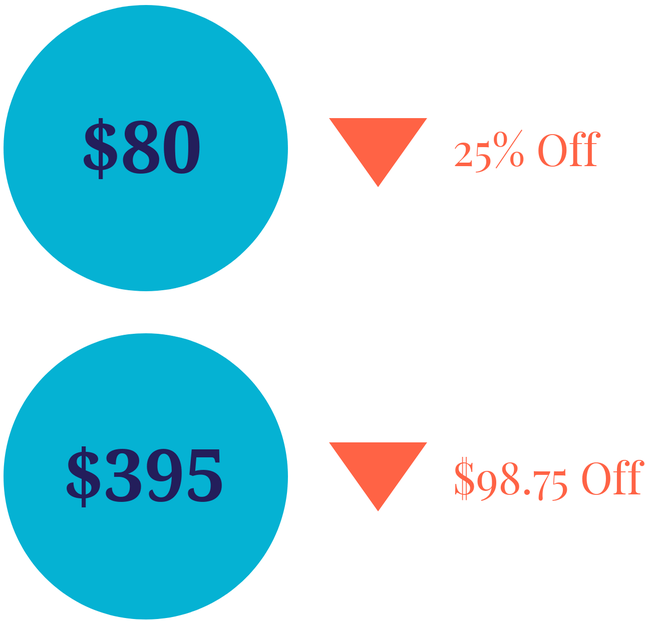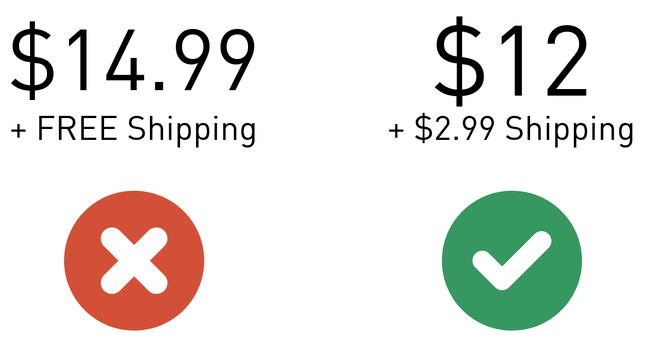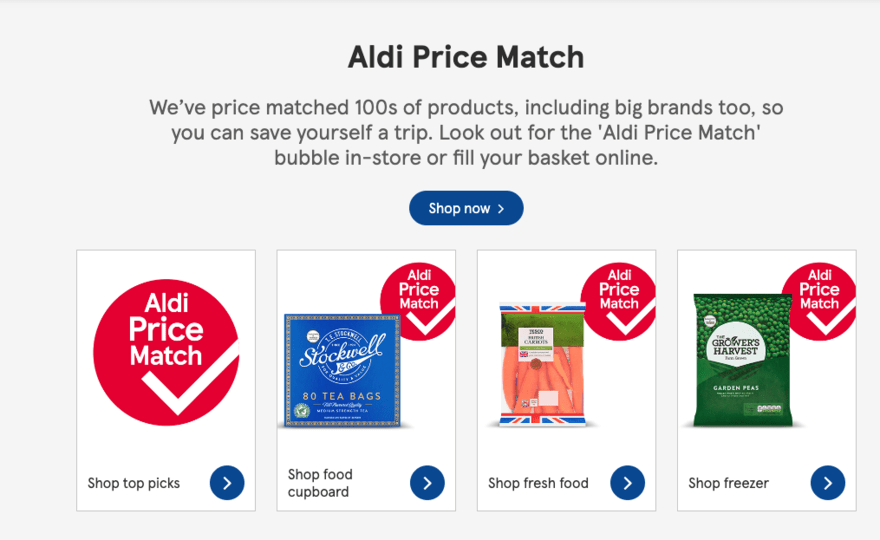How To Price a Product: Our Guide To Kickstart Your Profits
We may receive a commission from our partners if you click on a link and purchase a product or service on their website. Learn more
So, you’re all set up and ready to start selling with an ecommerce website builder, but you’re not sure how to price your products. It’s a common concern that almost every small business owner faces at the start – myself included! Ask too much, and your customers will go straight to your competitors. Ask too little, and nobody will take you seriously. Then there’s the issue of profits, markups, and margins – how do you calculate the selling price of a product to cover all your overheads?
I’m here to help. My guide will walk you through five steps to nail your product pricing, from the costs you need to identify to some psychology-backed pricing tips to give you a headstart over the competition. Let’s get started!
1. Decide Your Pricing Strategy
There are a plethora of methods you can use to finalize your product cost. In this guide, I’ll show you how to price a product using the most beginner friendly method: cost-plus pricing.
You simply need to select a percentage profit that you would like to make and add it to the price after cost:
For example, let’s assume your product costs $10 to make and you want to make 25% profit on each product you sell:
$10 (cost) + $2.50 (25% profit) = $12.50 (product price)
This is a great approach to start out with, especially if your costs are fairly easy to calculate and don’t fluctuate. This said, it won’t be the right strategy for every business, so it’s good to look into alternatives – more on that later!
Read on to find out how to price a product with the cost-plus strategy!
2. Add Up Your Costs
When deciding on how much you should charge for your product, you first need to identify all the potential costs that go into producing your final product. When you fail to do this, there is a potential to either drastically overcharge, or worse yet, under charge (at a loss) for the items you sell.
If you have a dropshipping business and order products to resell, this is a breeze! Simply make a note of the cost you paid your dropshipping supplier per unit.
If you make your own products, you’ll have to consider every stage involved in your product’s creation, which fall into three categories: materials, labour, and overheads.
Materials
Your material costs are any costs associated with the physical items that you sell. For example, material costs for an online cookie bakery may include:
- Flour
- Sugar
- Butter
- Chocolate chips
Labor
Labor costs will be what you pay yourself and your staff to run your business. For example, this could include:
- Warehouse staff pay
- In-house marketing team pay
- Your personal salary
Overheads
Typically, the term “overhead” is used to refer to any business costs that aren’t directly associated with the manufacture or purchase of your products. These are made up of:
- Fixed expenses, such as rent, salaries, insurance, and legal costs
- Variable expenses, which vary month to month, such as marketing, packaging, and telephone bills
3. Decide on Your Profit Margin
Now you understand the cost of your product, you need to take that value and add a markup to make a well-earned profit. The difference between the cost you pay to produce the product and the price you sell it at is known as the markup, and it’s usually shown as a percentage.
The standard usually sits between 20% and 50%, but you’ll need to take a look at prices for your specific market to make the best decision.
Understand Your Market
Whether you’re selling physical products like makeup or digital products like downloads, you’ll have to understand your customers’ expectations in order to set prices, especially on digital products. The last thing you want is cries of “How much?!” echoing from your product pages.
To get an idea of what prices your customers will agree with, explore the following:
- Research your competitors’ prices. Make a note of the price range you find. What are the most expensive and cheapest offers around? It’s unlikely you’ll want to set your prices any higher than the uppermost price tag, unless your product is unique enough to be obviously worth the money.
Enlist friends, family, and colleagues to take surveys for you. How much would they be willing to pay for your own products, or similar ones? Which competitor would they be most likely to choose, based on price? This should give you a realistic idea of what people would expect to pay

You should keep an eye on the market, and your competition, pretty much constantly. If a competitor runs a massive sale, you need to know about it. If a new brand pops up, you should take a look at their prices and decide whether you need to change your own strategy.
Think of yourself as a superspy – constant vigilance is key!
Olivia Bae, co-founder of haircare brand PERSEVE, realized there was a need for a more affordable, prestige formula shampoo on the market after her own experience with hair loss. When we interviewed her, she told us: “My mom and I had a lightbulb moment and made it our mission to make prestige formulas accessible to everyone.” As a result, they made sure all their products are priced under $20.
Read the full interview with PERSEVE to find out more about their journey, tips, and how they hit $200,000 in sales in 10 months.
Keep Your Markups Consistent
Once you’ve decided on the markup for your first product, it’s a good idea to work out the exact percentage so you can apply it to your whole inventory. That way, you can guarantee a consistent revenue across all your products and can scale this across the board as your business grows or your prices change.
The following formula will help you to calculate your markup:
This might look confusing, but I’ll break it down! You’ll divide your initial profit by the cost to make the product, then times it by 100.
For example, if you’re selling a product that costs $15 to produce and you want to sell it for $32, here’s how you would work out your markup:
($32-$15)/$15×100 = 113%
Identifying a consistent markup for your products is an easy way to ensure your profit margin stays on track.
4. Hook Your Customers
Finding the right price for your products is important. You need to cover your costs, make a profit, and keep up with your competitors. But there’s one last important factor: your customers!
The first rule is not to confuse, distract, or overwhelm your customers. Always keep pricing clear, uncluttered, and easy to process. Confused shoppers aren’t going to spend lots of money.

Luckily, there are a few tricks of the trade, and some nifty psychological moves you can make use of. Take a look through the tips below – you might find it opens your eyes to your own habits next time you go shopping!
Charm Pricing
Have you ever wondered why most prices are set at .99 cents instead of just rounding it up? Well, there’s a reason – people usually pay more attention to the left-hand number rather than the numbers after the decimal. So $9.99 looks infinitely better than $10!
This is called charm pricing, and is a tried and tested method used by most sellers. Don’t miss out – go through and change any round prices so they cost one cent less.

The 100 Rule
If you have a mix of products priced above and below $100, then this handy tip could come in useful.
“The Rule of 100” suggests that if you’re running a sale on items costing under $100, you should show it as a percentage discount. Whereas, if you’re running a sale on items costing over $100, you should show the savings in dollars.
Here’s an example:
- “25% off” for an item that costs $80.
- “$98.75 off” for an item that costs $395.

You’re not actually taking any extra money off the product – the customer is saving the exact same amount of money whether it’s shown as a number or a percentage. But the customer feels like they’re saving more, making them more likely to buy.
Unbundle Shipping
It can be tempting to increase your product price to include shipping costs – that way, you can offer “free” shipping to draw customers in.
This can be a successful tactic, but if you find it’s not working, it might be worth “unbundling” your costs. Instead of combining shipping, separate the cost so the product price seems lower.
For example: $12 + $2.99 shipping, rather than $14.99 + free shipping.
This can be an especially useful tactic if you’re selling in online bids on platforms like eBay.

Show Off Your Most Expensive Items
But, won’t that scare away my customers?
Not necessarily! In fact, it has been suggested as one of the most effective psychological tactics you can use. There are a few ways you can put this into practice.
- Put two similar products next to each other, with very different prices.
- Put them high up on your website, or display your products from most expensive to cheapest.
This way, your customers have this high price tag in mind, and are comparing all subsequent prices they see to this benchmark. The result? The rest of your products will seem like great value!
‘Buy One Get One Free’ is the godfather of all deals, but it’s a little tired now. Get inventive with your deals – offer half price items, savings for your customer next time they buy, or even the chance to unlock exclusive products or sales.
Jump on big sales events like Black Friday and Cyber Monday, and offer targeted sales around special occasions like Mother’s Day, Father’s Day, Christmas… you get the idea. You can even get inventive with this idea – if you sell pet accessories, why not run a sale for National Golden Retriever Day? (It’s every February 3rd, by the way, just so you know.)
If you can’t afford to run store-wide sales, why not offer discounts to targeted groups at particular times? For example, Tuesdays could be student discount day, Thursdays could be pensioner discounts, and weekends could offer family deals.
Find a niche that works for your business, and give your customers something enticing.
Always Be Clear On Savings
This is just good practice, but if you’re running a sale, you should always show the original price next to the new sale price. If you’ve discounted the product more than once, show each old price crossed out, with the current price clearly displayed.

This makes sure your pricing is transparent, and shows customers how much of a good deal they’re getting.
5. Don’t Stop; Keep Testing!
Once you’ve calculated your costs and tried out some of the psychological tactics we’ve outlined above, don’t stop. You can change your prices – they’re not set in stone. Keep testing them, and don’t forget to gather customer feedback!
As well as general tweaks and tests, here are some examples of times when you might want to consider changing your prices:
When Introducing New Products
When you introduce new products, don’t be afraid to make them a little more pricey than your older items. You can even lower the prices of your existing products if you can afford to – this could make them more appealing to customers, while adding more value to your shiny new additions!
Following an Increase in Product Cost
If for any reason your production costs increase, make sure you do the math to ensure your selling price is still covering your outgoings.
You may have already allowed some wiggle room, but if your markup or profit margins are a bit tight, it’s extra important to stay on top of the money going in and out. Remember, the key thing is for your business to make a profit!
If your products are already pretty expensive, take a look at how you could trim and save on your costs.
Due to External Influences on the Market
If prices are rising or falling, or new competitors are creeping in, you’d be wise to adjust your prices to make sure they stay relevant and competitive.
It can be hard to strike a balance between prices that are attractive, while still suggesting value to customers, but it’ll be impossible if you don’t keep your eye on the market.
Find Out More
- You can use AI for Dynamic Pricing to adjust your prices based on real-time factors such as demand, competitor pricing, and industry changes. Learn more about this in our full guide.
Your Pricing Model Options
This guide has shown you how to price a product using the cost-plus strategy, but there are a great deal of other options to choose from that might suit your business better:
Value-Based Pricing
Value-based pricing takes a different approach to pricing a product. Rather than asking:
“How much profit would we like to make?” as you would for cost-plus, you instead ask:
“How valuable is this product to consumers?”…or more accurately… “ What are consumers willing to pay?”
This is a more common approach for businesses where they have low competition or where the product is non-optional for the purchaser. For example, this model is often adopted in the pharmaceutical industry where production costs are often low, but products are protected by law and people have little option but to buy the product.
One major downside of value-based pricing is that when more competitors enter the market, this can have a serious impact on both your profitability and the reputation of your business. This is especially true if those competitors use another method of pricing such as cost-plus – drastically undercutting you.
Competitive Pricing

Competitive pricing is much as it sounds, pricing your products to beat the competition. Typically this means offering the same or similar products to your competitors at a lower cost.
Whether this cost is slightly lower or drastically lower will depend on the price sensitivity of your target audience as well as any other perceived benefits of choosing one of your competitors over you.
Recommended Retail Price (RRP)
RRP is a common approach for many retail stores. Especially those that resell products. This approach relies on a recommendation from the manufacturer for how much you should sell the product for, which is typically based on their own cost-plus equation.
Discount Pricing

Discount pricing is an approach to pricing products that relies on the heavy reduction of a price in order to achieve a specific goal. For example, a store may decide to discount a price so low that its competitors cannot possibly compete, letting them grow its market share – ultimately giving them the power to increase prices at a later date.
This can be a risky approach to pricing. This is especially true if you get into a “price war” with competitors, since it can sometimes lead to a loss of profits.
Find Out More
You can even adjust pricing in real-time via AI Dynamic Pricing, which factors in market fluctuations to always ensure smart pricing. Learn more about how this works and whether you should use it in our full guide.
Summary
Pricing products can be daunting, especially when you’re just starting out. But it doesn’t have to be. Start off by choosing a pricing strategy that best suits your business’ needs while keeping your customers satisfied. Then you can calculate your price by adding the cost of your product to your chosen markup. Don’t forget to check the competition to make sure your prices aren’t too out of the ordinary! Once you’ve done this, you can attract customers to your online store by finetuning your sales tactics and continually assessing the market for changes.
As your business grows and your confidence in pricing products grows too, you’ll likely start finding your own tips, tricks, and insider know-how to add to this list. But for now, my guide is here to help get you started!
2 comments